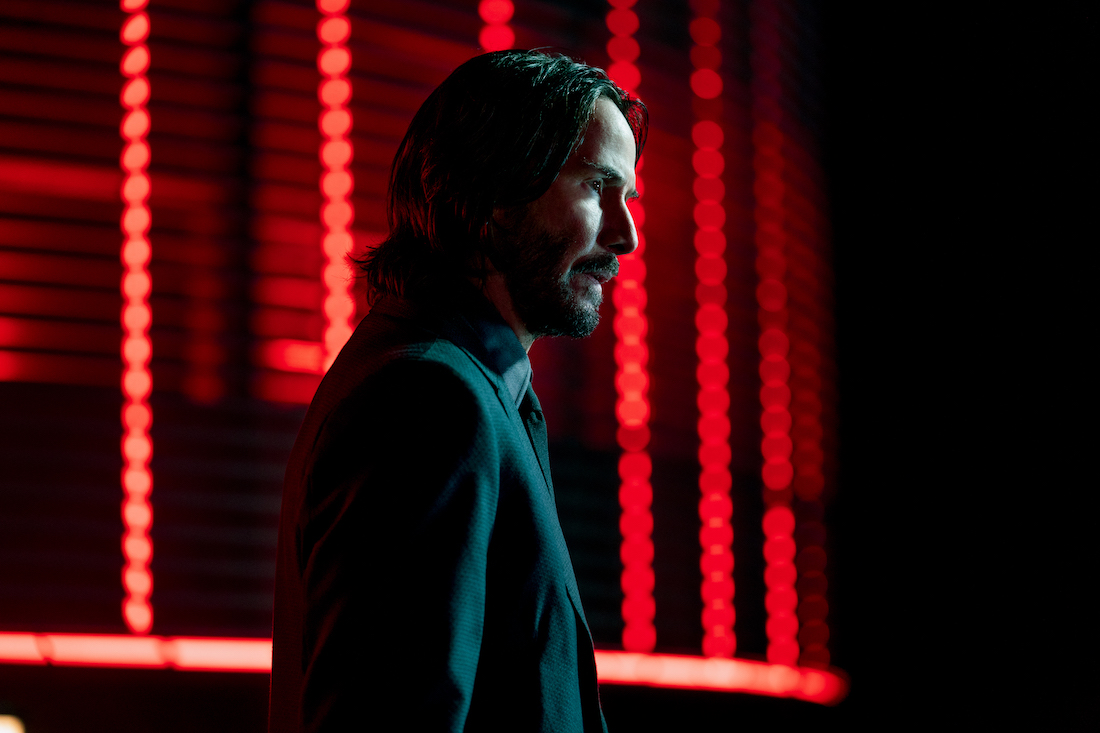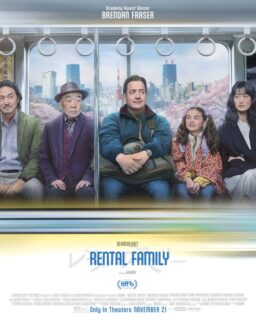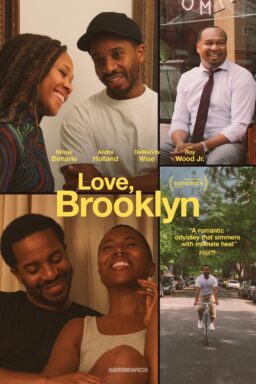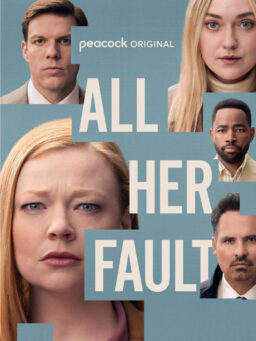Director Chad Stahelski has a John Wick-esque hunger for beating a challenge, starting with his days as a stuntman (later doubling for his star, Keanu Reeves) before moving on to martial arts choreography and second-unit directing. That background offered a special intuition for his impressive directorial debut (with co-director David Leitch), “John Wick.” The premise of that movie—an assassin gets revenge for the dead puppy originally gifted by his now-deceased wife—has expanded into an action universe that bows before Sergio Leone, Akira Kurosawa, Jackie Chan, Buster Keaton, John Woo, David Lean, and many more. Wick’s epic journey of revenge began on his kitchen floor. Now, Stahelski and his innovative creative team are pushing the action genre with settings like the Arc de Triomphe, Sacre Coeur, and the Louvre serving as their backdrop.
Over its 165-minute runtime, “John Wick: Chapter 4” is filled with the cinematic integrity (as many cohesive fight scenes as you can fit) that has made Stahelski’s franchise so popular, if not subversive to regular modern standards for Hollywood action. Part of that is thanks to his incredible international cast of fighters, including martial arts legends like Donnie Yen, Scott Adkins, Hiroyuki Sanada, and Marko Zaror, whose punches and kicks keep the storytelling visceral. They share the screen with dramatic heavyweights like Ian McShane, Laurence Fishburne, Shamier Anderson, the late Lance Reddick, Clancy Brown, and Bill Skarsgard. Keanu Reeves is at the center of this universe as the targeted Wick, fighting his way to a good night’s rest one adversary and one stunning sequence at a time.
Stahelski spoke with RogerEbert.com on opening day about the making of each major fight sequence, the Sisyphean fight scene that pays homage to Buster Keaton, the “director ego” shot of Ian McShane walking in the Louvre, and more.
Spoilers follow for John Wick: Chapter 4.

Do you have any opening day traditions?
No, but I have a post-opening day tradition. Keanu and I get together on the Monday after, and there’s a bottle of champagne and there’s a bottle of whiskey, depending on which way it goes. Keanu and I will get together, we’ll cheers each other one way or the other, and I reckon we’ll read a bunch of reviews. We’ll read some good ones, we’ll read all the bad ones and make fun of them and make fun of ourselves, and just be happy for being here. We had a great opportunity to make this thing. You gotta celebrate that first, and then you can be depressed afterwards.
It sounds like you guys like to keep it humble.
What else can you keep it, right?
I have written recently about your history as a stuntman, and that of your peers like other stuntperson-turned-directors like David Leitch (“Atomic Blonde“) and J.J. Perry (“Day Shift“). How did your history with taking car-hits influence how you conceptualized the Arc de Triomphe action scene, which is packed with them?
Yeah, it looks like I have a fetish for car hits and stair falls, doesn’t it? But I do. I was a body stuntman, I did a lot of fight scenes and wire gags. I got hit by more fight scenes and more wire gags, whether it’s flying or getting yanked in the back of the head or car-hits, than anything else I did in the industry.
It’s funny, you jump out of a plane, and not a lot of people can relate to that, but everybody can relate to slipping on ice. Everybody can relate to getting hit by a door or punched in the face or kicked in the groin. I guess that was what was so effective when I watched Buster Keaton or Harold Lloyd, or Jackie Chan, for modern-day cinema. Sometimes, the more relatable pain or humorous pain, if the audience can experience it with the character on-screen, it becomes more effective. No one has jumped 300 feet in a car. Although it’s visually impressive, it’s hard to know what it’s like and to feel that. So we try to keep the gags and the stunts where you go, “Ooh!” and crying out. That’s kind of my fetish, I like everybody to feel the same thing the characters feel.
That makes me think of the stair sequence in this film as well. It’s joke-then-fight-then-joke.
It’s really based on my love of Buster Keaton. But it’s like Sisyphus, right? He rolled the boulder up, just for it to come down. It’s such a mythological theme in “John Wick” since the beginning. We just want to see the struggle this guy goes through, and as soon as he makes it, I’m going to take it away from him. You feel that cathartic effect of, “Ah, f**k! He’s got to do it again?” And then put something special in the second time. You always got to do it in threes, right? I throw him down twice, but the third time he makes it.
It really pays off, comedically, when he goes down and down and down and keeps tumbling. Was there any worry about doing that stunt?
Those stair-falls, there’s no stitch. That is Vincent Bouillon, Keanu’s double from France, that did it all. He did it on the second take. The first take, he only made it five, six steps and got stuck. The second take, he made it all the way down.
Was that sequence more planned out because of the location?
We knew we wanted to do the end sequence in front of Sacre Coeur, but it wasn’t until I scouted Paris with my stunt coordinator, Scott Rogers. The sun was already set, we were walking away from the church, and we looked down at the staircase. We both smiled and went, “I wonder who is going down this?” We went back, and we were like, “No, I’m not gonna throw him down. We’re going to make him fight his way up, then we’re gonna throw him down, and then he’s going to fight his way back up, and I’ll put Donnie for this whole metaphor for brotherhood.” We literally wrote that sequence on the van ride back.
Donnie has an amazing wind-up punch early in the film. Was that his idea?
Oh yeah, that’s all Donnie, a Sugar Ray Leonard reference. He’s a huge Sugar Ray Leonard fan; he’s put that in “Flashpoint,” and he’s put that in a lot of his films. Funny thing, I had lunch with Donnie yesterday. We brought that up a lot. A lot of his hometown audiences don’t really know who Sugar Ray Leonard was in China, so they don’t get that cool reference. And he does it in his movies, and Western audiences don’t really get it. So, we were talking about that a year or two ago on set, and he said, “Hey man, I’m going to do an Ip Man, I’m gonna do a straight blast and speed punch,” and then Donnie started laughing. “I don’t know why, I just feel like I need to do this.” So I’m like, “Alright, do it, let’s shoot it, let’s see if we like it,” And he shoots it, and everybody behind the camera starts laughing. He’s so f**king fast.

Another legend peeking in there is Sammo Hung. I feel like he’s behind Scott Adkins’ makeup and presence as Killa.
Yes, Sammo Hung in “SPL,” and the purple suit. I love Scott, and I have known Scott for 20 years. Scott, I don’t know if you’ve ever met him, is one of the best-looking and most athletic people you’ll ever meet. It’s silly. My whole point is that if I had Scott walk into a scene and did seven pages of dialogue first, the audience knows there will be a fight. So I wanted to do a little subversive thing where you didn’t know it was coming, so I wanted to keep focused on the character and Scott’s acting ability and how he carries the scene. And then, without ever seeing it coming, he does a fake-out and runs away, and turns around and starts hooking John Wick.
It’s exciting that Scott has this platform, and he’s been killing it on all the morning talk shows recently, teaching the hosts martial arts. Talk about someone primed for the giant audience they deserve.
I hope so. Keanu and I love him to death, and he is so talented.
I read that you worked with the newer Alexa cameras to shoot this film?
The Alexa 35, yeah.
How did that help you push even more your vision for the “John Wick” universe?
Oh my god, the whole color range on that thing. Like, I’ve always liked Alexas, I don’t know why; they just seem to fit. But we’ve always had a problem with reds and going big with the highlights and the contrast. You saw what we did in Osaka with all of the reds. The Alexas are great, it crunches the blacks, you can see the range we pushed on this one. We did it at least ten percent bigger than any “John Wick” film. My colorist, Jill Bogdanowicz, she’s probably the best colorist in the world. I love her to death. So between her and Dan Laustsen, we could take the color range so much further, but we couldn’t have done it if the Alexa didn’t capture it.
How did you coordinate the overhead oner fight sequence with DP Dan Laustsen? How did you crack it visually?
The first time I pitched it to Dan … god I wish I could speak the actual words he used. But they weren’t encouraging. Top shots are a little tricky, you have to light from the side. It may not be interesting because you’re just looking at a f**king floor. So, I was like, “You know what, Dan, you’re absolutely right. Let me go think about this.” So we went back, and we looked at all these other movies that had done it, and video games that had done it, and anime that had done it. And we kind of took a little piece of wisdom from all of them about how to change the look of the floors and to use the dragon’s breath [from the shotguns] as a lighting reference. We want to light guys on fire and for the fire to be the light references. How do you work with windows, and the trick was a lot of a little.
Keep changing the set pieces, keep changing the lighting themes, and use everything you can for practical lighting. For design and choreography to be interesting from the top shot, not just choreograph to see what happens. But all the stunt guys were required to choreograph from a top shot angle. We just had to put a lot more thought into making it interesting than we thought we needed. That was a big learning curve. Again, it was a big part of how do we make it interesting? How do we keep it going and make it visually stunning? I think we succeeded.
Which comes first with a sequence like that, the shot or the story for that?
Definitely wanted to do that shot; I just had no idea how to make it great. I had done plenty of top shots and oners before. At that point, the action needs a little lift in the third act. OK, we’re going for broke, we have 45 minutes of action; how do we keep the audience going “What the f**k?” And that’s visual style, it’s choreography, it’s performance, it’s music, it’s all of that. And it’s about, how do we create a synergy with this piece, the Arc de Triomphe, and the staircase?
Is there some sort of a one-upmanship with oner sequences between you and your stuntman-turned-directors peers?
We’re fairly insular when we go into creative mode, we just want to do what’s good for us. There’s not a competition. Afterwards, we’ll probably all talk shit, probably. [laughs] In a fun way, we’re all pretty close.
But no, I always try to work from the perspective as an audience member. If I think it’s cool and it tingles me, then I’m like, “OK, we’re on the right path.” And then you get your creatives to work. I just think that’s always it. If you’re not excited by it, there’s no sense in trying to justify that other people will like it. Again, that’s OK, but “You know, people are gonna love it”—I heard that a lot growing up in the industry. And I’m like, “If none of us think it’s cool … what? How does that work?”
I always tell my stunt team, “If you’re not impressed by it, don’t show it to me.” I don’t want to find what the audience finds mediocre, I don’t care. If you don’t have something that’s gonna make you clap, they’re not going to clap.
And there are plenty of action movies that try to cut around that.
They’re always trying to … again, I have nothing against editing, I have nothing against Shakicam. It’s when you do it in place of something, when you don’t have the money or the time, or the creative thought or the energy and you hide behind what you don’t have. I’m all about showing off what I have: I have Keanu Reeves, I have a great stunt team, and I have great locations. I’m gonna show people the world that I’m in. So don’t hide. Be creative. Being creative is free. You just have to work, and it makes people’s heads hurt. Everybody always says, “I want something new, I want something fresh,” and I’m like, “OK, you got to go out and earn that. It doesn’t just fall out of the sky.” You gotta try, you gotta fail, you gotta stand back up and fail again, and fail again, and fail again, until you get it right.

Did being a stuntman give you that hunger for creativity, or do we have to look back even further in your life?
My mom and dad are pretty incredible people. I come from a great family. Mom and dad were both incredibly athletic and incredibly intellectual, and they both love to read. They both were very well-read, smart people. They both started companies when they were very, very young and have interesting histories, I don’t want to bore you with it. Me and my brothers came up that way, where they wanted us to be athletic and resourceful, and well-read. Everything was rewarded; you did a good job you got to play in the woods, don’t stay inside. Whatever wish—I wanted to do karate, judo, BMX, motorcycles—and they were like, “Cool, go do it.” I felt very supported.
So I think it really comes from them, but if you met my mom and dad, you’d be like, “Ahh, OK. I get it.” [laughs] So I think that’s why I went into stunts and not the other way around.
They understand that sometimes creativity … I don’t know who or when in human history devised the athlete-scholar-warrior mentality. If you’re in shape you’re going to have a better intellectual mind; if you’re unbalanced … I mean, unbalanced is bad in any aspect of life. Athleticism doesn’t mean being an Olympic athlete; it just means you’re active and exploring the world. You can do things, you can explore your physical world as much as your intellectual world. I believe in the yin and yang of that.
How do you feel any of your fears or anxieties about directing have changed since making the first movie?
Oh, I’m just as terrified. I have just as much anxiety. And you ask most directors what’s the hardest part of the day, and most of us would answer, “Getting out of the car.” But it’s about what you do after you get out of the car. I guess that’s the real question you’re asking. I was terrified as a first-time director, but you get out of the car, and you manage that fear.
For me, for every shot I do first, I try to make it the most beautiful shot of the day. It just puts my head in the right space and lets the crew know that I’m here to make something special, whether it’s an insert, a wide shot, a stunt, a dolly-up, a close-up, a medium. No matter what it takes, it’s going to be beautiful. And that reminds me, “Relax, you’re here to make something beautiful, and the crew knows that you’re here, and they respect the craft.” But it’s about dealing with the fear, and knowing that you’re supposed to make mistakes, and even though I’m the director, I’m not supposed to know everything. But I do have to make the decisions. If it’s a bad decision, do it again, you gotta fix it. That’s directing. It’s a lot more than yelling “Action” and “Cut.”
That reminds me of a shot I was hoping I could ask you about: Ian McShane walking for about 15 seconds in front of all of those massive paintings.
[laughs] Yes, that’s a director ego shot. I’m not gonna lie to you, it’s I’m shooting in the Louvre, you know? But after the tension of the last scene, that whole scene in the Louvre is about Winston rebalancing power. It’s Winston’s comeback, it’s the power shift dynamic. And I want you to feel power, his character and with me, to have the confidence to let that play out. To show you he’s entering into the world of Gods, he’s coming into this world of deities, and he’s coming in to shift the balance. But yeah in the back of my head it’s the F**k you, I’m shooting in the Louvre. Look how cool that is.
Did you have to fight to keep that moment? I know that the original cut was an hour longer.
You know, by the time we got to that point between the studio and I, after a few “John Wick”s and after the test screening where people just laughed, it seemed like everybody gets it. You never want to cut a great moment like that, and I think the fact that most audiences laughed and responded to it, they understood what it was really about. It wasn’t just a long shot. Honestly, the studio has been really great. It’s not every day the studio backs a two-hour, 38-minute movie with ten minutes of credits.
It was a bit of a fight, but not in the way you think. It wasn’t a fight about the runtime, it was a fight about why the runtime. You can only justify that when you watch it with an audience and you realize moments that were keeping them engaged. The whole gag of the movie is to have longer than long fight scenes—we’re making fun of ourselves. We’re making fun of the genre. We don’t want to take them too seriously, we’re trying to make this fun. The whole gag is excess. That’s the whole moral of the story, the theme of this John Wick mythology.
“John Wick: Chapter 4” is now playing in theaters.












